NSB204 Case Study: Mental Health Assessment of Mary's Depression
VerifiedAdded on 2023/06/04
|11
|2573
|467
Case Study
AI Summary
This case study focuses on a 41-year-old female named Mary, presenting with symptoms of depression. The assignment begins with a Mental Status Examination (MSE) evaluating her appearance, attitude, mood, affect, speech, thought process, thought content, insight, impulsivity, and reliability. Part 1 includes a clinical formulation based on the 5Ps (Predisposing, Precipitating, Perpetuating, Protective, and Presentation) and a detailed nursing care plan addressing Mary's low self-confidence, feelings of worthlessness, and sleep difficulties. The nursing interventions emphasize counseling, family involvement, and establishing a regular sleep schedule. Part 2 delves into therapeutic engagement, highlighting the importance of a therapeutic relationship and cultural safety in providing care. It also discusses recovery-oriented nursing care principles, such as patient uniqueness, real choices, and partnership. The case study concludes with references and a clinical handover plan, emphasizing the family's role in Mary's recovery.
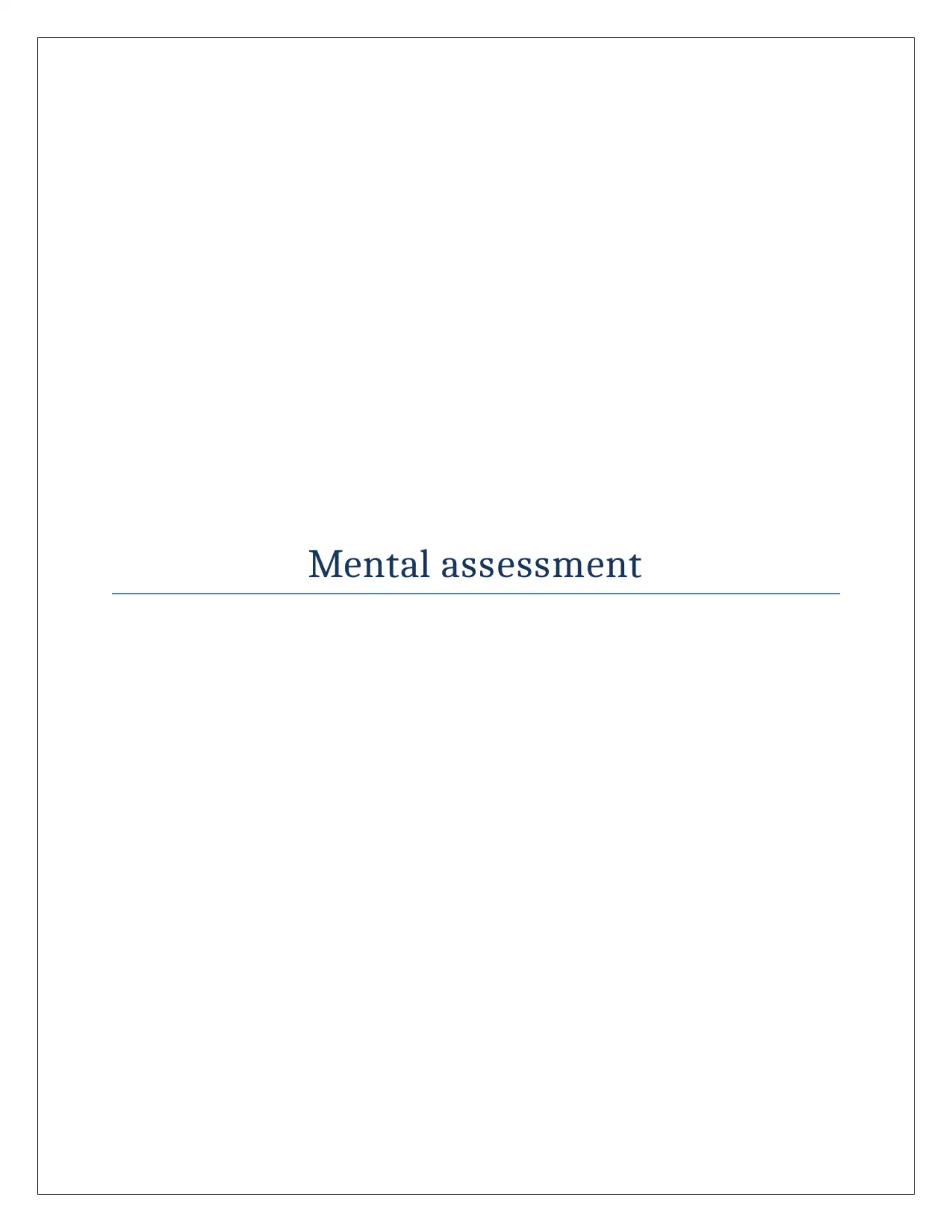
Mental assessment
Paraphrase This Document
Need a fresh take? Get an instant paraphrase of this document with our AI Paraphraser
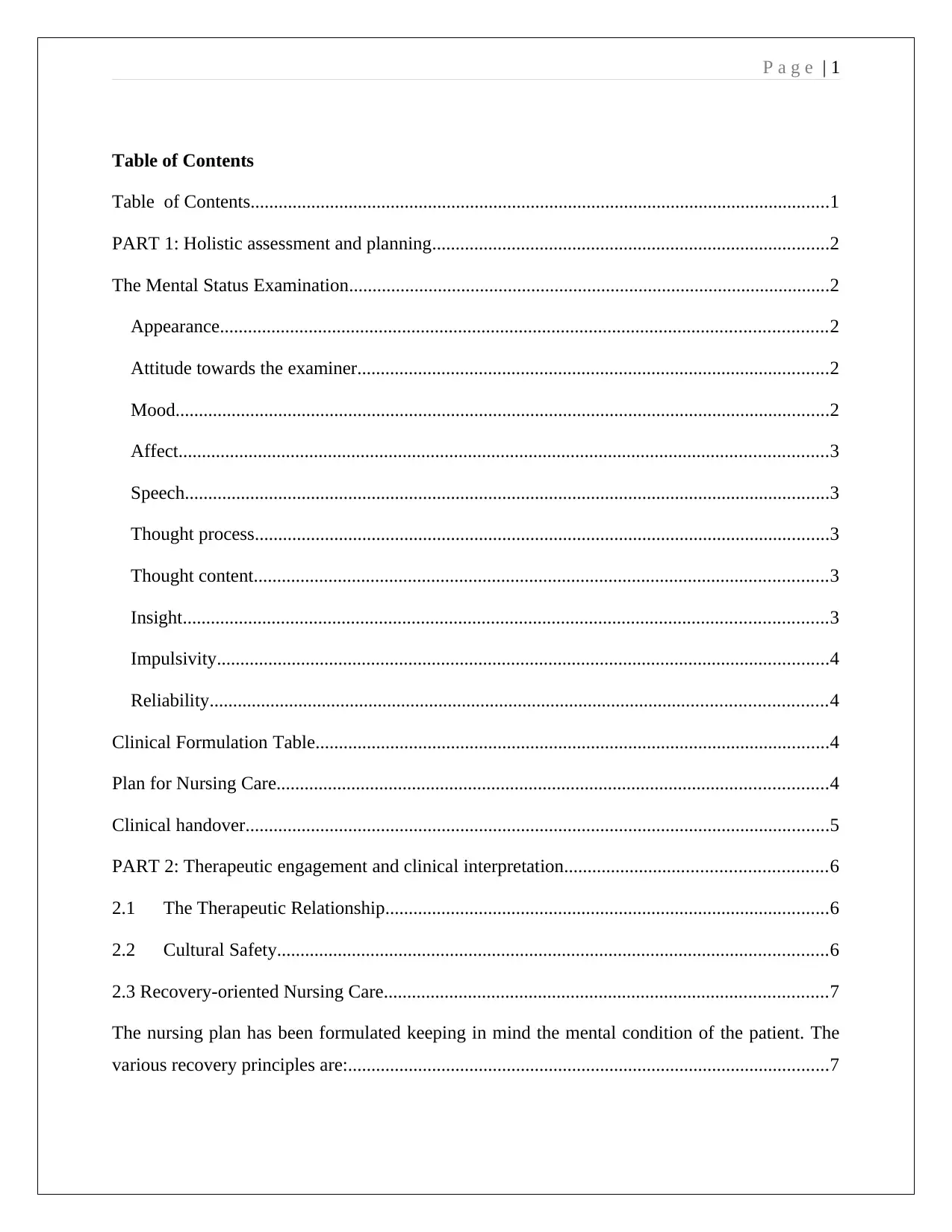
P a g e | 1
Table of Contents
Table of Contents............................................................................................................................1
PART 1: Holistic assessment and planning.....................................................................................2
The Mental Status Examination.......................................................................................................2
Appearance..................................................................................................................................2
Attitude towards the examiner.....................................................................................................2
Mood............................................................................................................................................2
Affect...........................................................................................................................................3
Speech..........................................................................................................................................3
Thought process...........................................................................................................................3
Thought content...........................................................................................................................3
Insight..........................................................................................................................................3
Impulsivity...................................................................................................................................4
Reliability....................................................................................................................................4
Clinical Formulation Table..............................................................................................................4
Plan for Nursing Care......................................................................................................................4
Clinical handover.............................................................................................................................5
PART 2: Therapeutic engagement and clinical interpretation........................................................6
2.1 The Therapeutic Relationship...............................................................................................6
2.2 Cultural Safety......................................................................................................................6
2.3 Recovery-oriented Nursing Care...............................................................................................7
The nursing plan has been formulated keeping in mind the mental condition of the patient. The
various recovery principles are:.......................................................................................................7
Table of Contents
Table of Contents............................................................................................................................1
PART 1: Holistic assessment and planning.....................................................................................2
The Mental Status Examination.......................................................................................................2
Appearance..................................................................................................................................2
Attitude towards the examiner.....................................................................................................2
Mood............................................................................................................................................2
Affect...........................................................................................................................................3
Speech..........................................................................................................................................3
Thought process...........................................................................................................................3
Thought content...........................................................................................................................3
Insight..........................................................................................................................................3
Impulsivity...................................................................................................................................4
Reliability....................................................................................................................................4
Clinical Formulation Table..............................................................................................................4
Plan for Nursing Care......................................................................................................................4
Clinical handover.............................................................................................................................5
PART 2: Therapeutic engagement and clinical interpretation........................................................6
2.1 The Therapeutic Relationship...............................................................................................6
2.2 Cultural Safety......................................................................................................................6
2.3 Recovery-oriented Nursing Care...............................................................................................7
The nursing plan has been formulated keeping in mind the mental condition of the patient. The
various recovery principles are:.......................................................................................................7
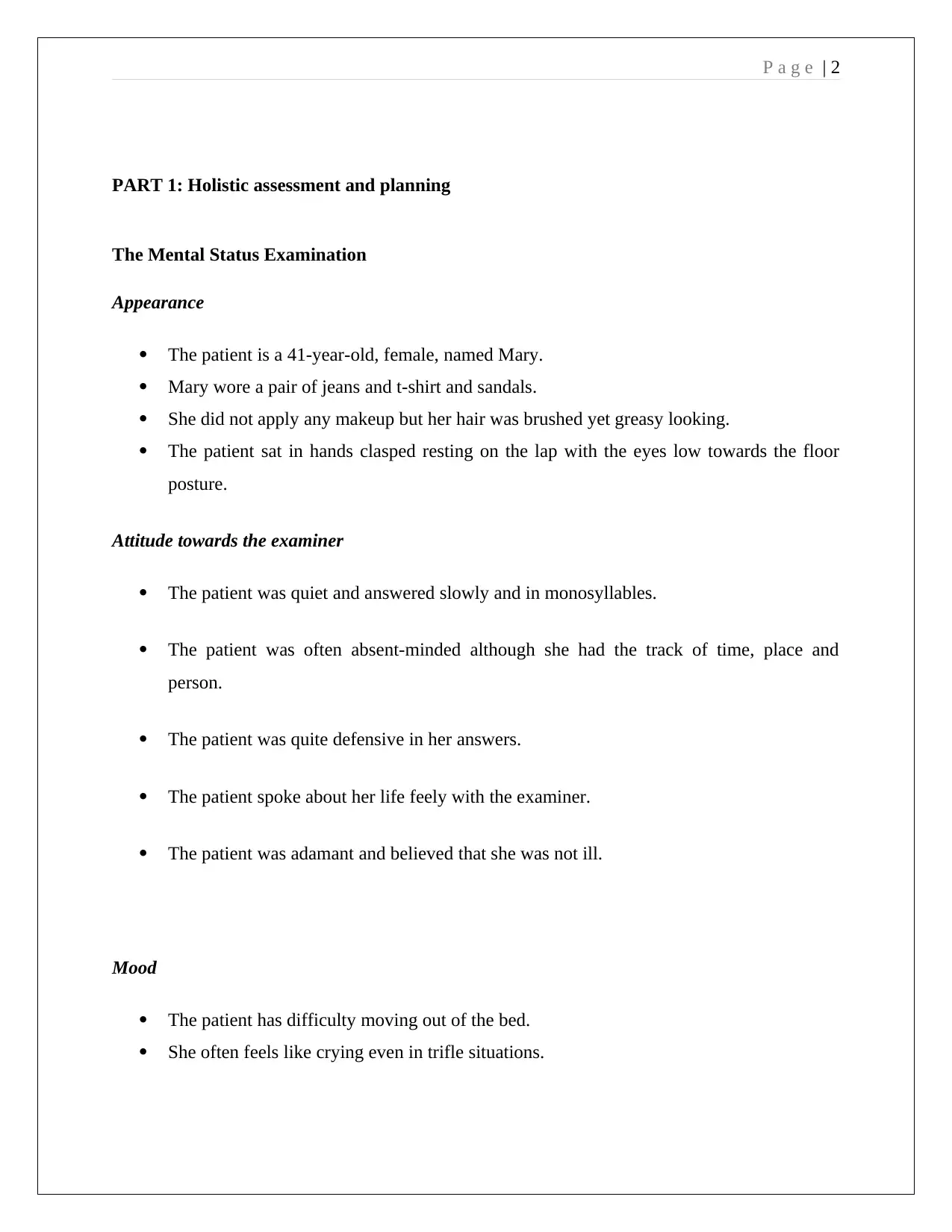
P a g e | 2
PART 1: Holistic assessment and planning
The Mental Status Examination
Appearance
The patient is a 41-year-old, female, named Mary.
Mary wore a pair of jeans and t-shirt and sandals.
She did not apply any makeup but her hair was brushed yet greasy looking.
The patient sat in hands clasped resting on the lap with the eyes low towards the floor
posture.
Attitude towards the examiner
The patient was quiet and answered slowly and in monosyllables.
The patient was often absent-minded although she had the track of time, place and
person.
The patient was quite defensive in her answers.
The patient spoke about her life feely with the examiner.
The patient was adamant and believed that she was not ill.
Mood
The patient has difficulty moving out of the bed.
She often feels like crying even in trifle situations.
PART 1: Holistic assessment and planning
The Mental Status Examination
Appearance
The patient is a 41-year-old, female, named Mary.
Mary wore a pair of jeans and t-shirt and sandals.
She did not apply any makeup but her hair was brushed yet greasy looking.
The patient sat in hands clasped resting on the lap with the eyes low towards the floor
posture.
Attitude towards the examiner
The patient was quiet and answered slowly and in monosyllables.
The patient was often absent-minded although she had the track of time, place and
person.
The patient was quite defensive in her answers.
The patient spoke about her life feely with the examiner.
The patient was adamant and believed that she was not ill.
Mood
The patient has difficulty moving out of the bed.
She often feels like crying even in trifle situations.
⊘ This is a preview!⊘
Do you want full access?
Subscribe today to unlock all pages.

Trusted by 1+ million students worldwide
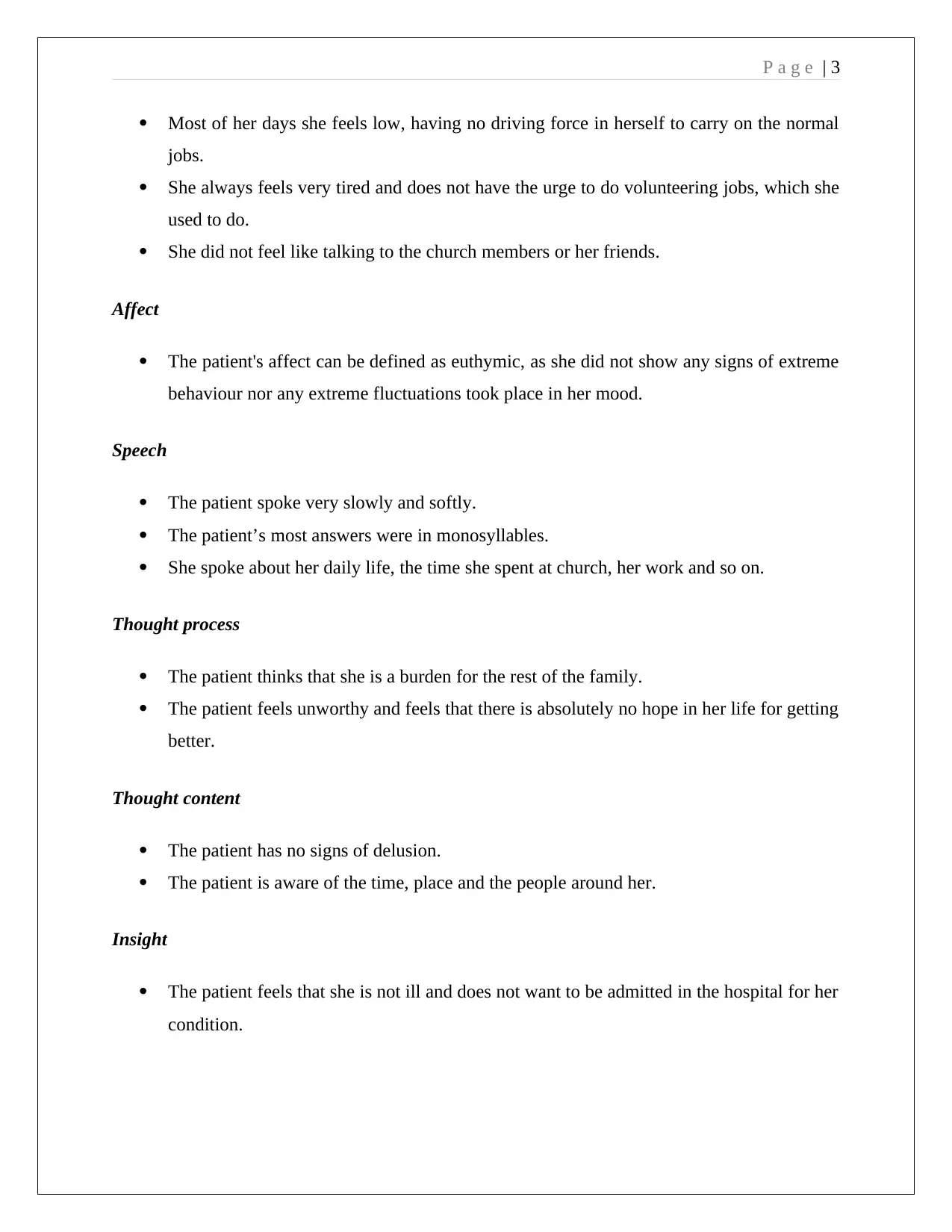
P a g e | 3
Most of her days she feels low, having no driving force in herself to carry on the normal
jobs.
She always feels very tired and does not have the urge to do volunteering jobs, which she
used to do.
She did not feel like talking to the church members or her friends.
Affect
The patient's affect can be defined as euthymic, as she did not show any signs of extreme
behaviour nor any extreme fluctuations took place in her mood.
Speech
The patient spoke very slowly and softly.
The patient’s most answers were in monosyllables.
She spoke about her daily life, the time she spent at church, her work and so on.
Thought process
The patient thinks that she is a burden for the rest of the family.
The patient feels unworthy and feels that there is absolutely no hope in her life for getting
better.
Thought content
The patient has no signs of delusion.
The patient is aware of the time, place and the people around her.
Insight
The patient feels that she is not ill and does not want to be admitted in the hospital for her
condition.
Most of her days she feels low, having no driving force in herself to carry on the normal
jobs.
She always feels very tired and does not have the urge to do volunteering jobs, which she
used to do.
She did not feel like talking to the church members or her friends.
Affect
The patient's affect can be defined as euthymic, as she did not show any signs of extreme
behaviour nor any extreme fluctuations took place in her mood.
Speech
The patient spoke very slowly and softly.
The patient’s most answers were in monosyllables.
She spoke about her daily life, the time she spent at church, her work and so on.
Thought process
The patient thinks that she is a burden for the rest of the family.
The patient feels unworthy and feels that there is absolutely no hope in her life for getting
better.
Thought content
The patient has no signs of delusion.
The patient is aware of the time, place and the people around her.
Insight
The patient feels that she is not ill and does not want to be admitted in the hospital for her
condition.
Paraphrase This Document
Need a fresh take? Get an instant paraphrase of this document with our AI Paraphraser
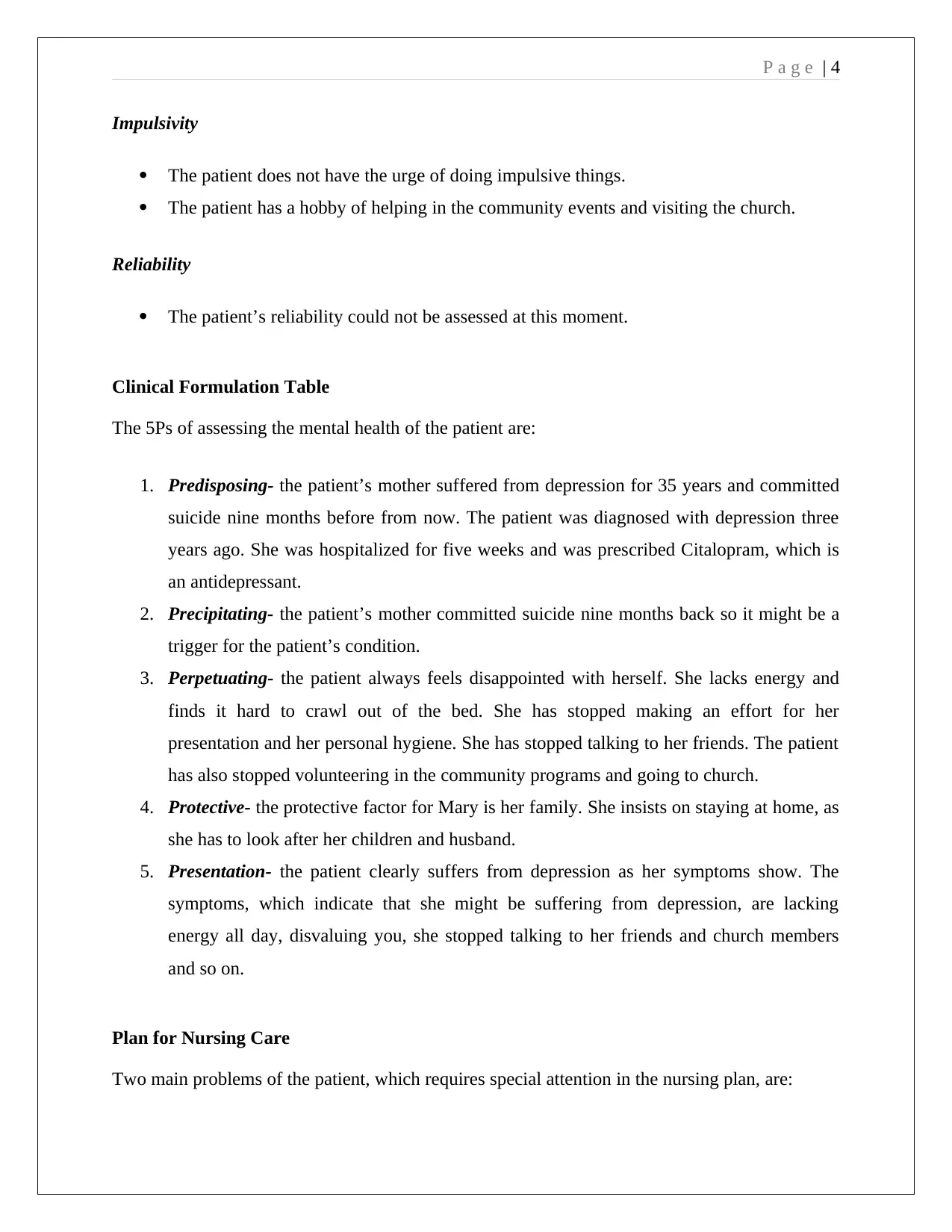
P a g e | 4
Impulsivity
The patient does not have the urge of doing impulsive things.
The patient has a hobby of helping in the community events and visiting the church.
Reliability
The patient’s reliability could not be assessed at this moment.
Clinical Formulation Table
The 5Ps of assessing the mental health of the patient are:
1. Predisposing- the patient’s mother suffered from depression for 35 years and committed
suicide nine months before from now. The patient was diagnosed with depression three
years ago. She was hospitalized for five weeks and was prescribed Citalopram, which is
an antidepressant.
2. Precipitating- the patient’s mother committed suicide nine months back so it might be a
trigger for the patient’s condition.
3. Perpetuating- the patient always feels disappointed with herself. She lacks energy and
finds it hard to crawl out of the bed. She has stopped making an effort for her
presentation and her personal hygiene. She has stopped talking to her friends. The patient
has also stopped volunteering in the community programs and going to church.
4. Protective- the protective factor for Mary is her family. She insists on staying at home, as
she has to look after her children and husband.
5. Presentation- the patient clearly suffers from depression as her symptoms show. The
symptoms, which indicate that she might be suffering from depression, are lacking
energy all day, disvaluing you, she stopped talking to her friends and church members
and so on.
Plan for Nursing Care
Two main problems of the patient, which requires special attention in the nursing plan, are:
Impulsivity
The patient does not have the urge of doing impulsive things.
The patient has a hobby of helping in the community events and visiting the church.
Reliability
The patient’s reliability could not be assessed at this moment.
Clinical Formulation Table
The 5Ps of assessing the mental health of the patient are:
1. Predisposing- the patient’s mother suffered from depression for 35 years and committed
suicide nine months before from now. The patient was diagnosed with depression three
years ago. She was hospitalized for five weeks and was prescribed Citalopram, which is
an antidepressant.
2. Precipitating- the patient’s mother committed suicide nine months back so it might be a
trigger for the patient’s condition.
3. Perpetuating- the patient always feels disappointed with herself. She lacks energy and
finds it hard to crawl out of the bed. She has stopped making an effort for her
presentation and her personal hygiene. She has stopped talking to her friends. The patient
has also stopped volunteering in the community programs and going to church.
4. Protective- the protective factor for Mary is her family. She insists on staying at home, as
she has to look after her children and husband.
5. Presentation- the patient clearly suffers from depression as her symptoms show. The
symptoms, which indicate that she might be suffering from depression, are lacking
energy all day, disvaluing you, she stopped talking to her friends and church members
and so on.
Plan for Nursing Care
Two main problems of the patient, which requires special attention in the nursing plan, are:
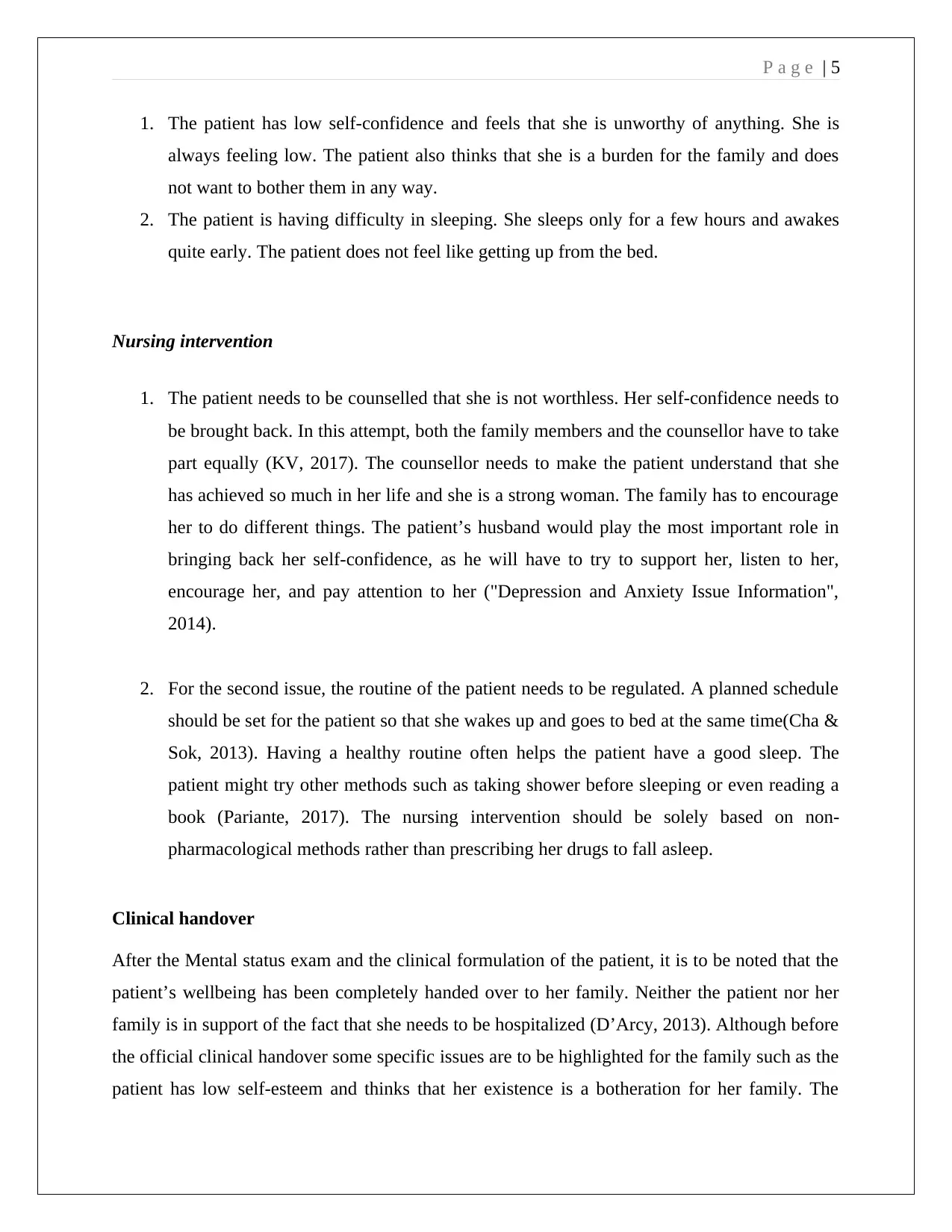
P a g e | 5
1. The patient has low self-confidence and feels that she is unworthy of anything. She is
always feeling low. The patient also thinks that she is a burden for the family and does
not want to bother them in any way.
2. The patient is having difficulty in sleeping. She sleeps only for a few hours and awakes
quite early. The patient does not feel like getting up from the bed.
Nursing intervention
1. The patient needs to be counselled that she is not worthless. Her self-confidence needs to
be brought back. In this attempt, both the family members and the counsellor have to take
part equally (KV, 2017). The counsellor needs to make the patient understand that she
has achieved so much in her life and she is a strong woman. The family has to encourage
her to do different things. The patient’s husband would play the most important role in
bringing back her self-confidence, as he will have to try to support her, listen to her,
encourage her, and pay attention to her ("Depression and Anxiety Issue Information",
2014).
2. For the second issue, the routine of the patient needs to be regulated. A planned schedule
should be set for the patient so that she wakes up and goes to bed at the same time(Cha &
Sok, 2013). Having a healthy routine often helps the patient have a good sleep. The
patient might try other methods such as taking shower before sleeping or even reading a
book (Pariante, 2017). The nursing intervention should be solely based on non-
pharmacological methods rather than prescribing her drugs to fall asleep.
Clinical handover
After the Mental status exam and the clinical formulation of the patient, it is to be noted that the
patient’s wellbeing has been completely handed over to her family. Neither the patient nor her
family is in support of the fact that she needs to be hospitalized (DʼArcy, 2013). Although before
the official clinical handover some specific issues are to be highlighted for the family such as the
patient has low self-esteem and thinks that her existence is a botheration for her family. The
1. The patient has low self-confidence and feels that she is unworthy of anything. She is
always feeling low. The patient also thinks that she is a burden for the family and does
not want to bother them in any way.
2. The patient is having difficulty in sleeping. She sleeps only for a few hours and awakes
quite early. The patient does not feel like getting up from the bed.
Nursing intervention
1. The patient needs to be counselled that she is not worthless. Her self-confidence needs to
be brought back. In this attempt, both the family members and the counsellor have to take
part equally (KV, 2017). The counsellor needs to make the patient understand that she
has achieved so much in her life and she is a strong woman. The family has to encourage
her to do different things. The patient’s husband would play the most important role in
bringing back her self-confidence, as he will have to try to support her, listen to her,
encourage her, and pay attention to her ("Depression and Anxiety Issue Information",
2014).
2. For the second issue, the routine of the patient needs to be regulated. A planned schedule
should be set for the patient so that she wakes up and goes to bed at the same time(Cha &
Sok, 2013). Having a healthy routine often helps the patient have a good sleep. The
patient might try other methods such as taking shower before sleeping or even reading a
book (Pariante, 2017). The nursing intervention should be solely based on non-
pharmacological methods rather than prescribing her drugs to fall asleep.
Clinical handover
After the Mental status exam and the clinical formulation of the patient, it is to be noted that the
patient’s wellbeing has been completely handed over to her family. Neither the patient nor her
family is in support of the fact that she needs to be hospitalized (DʼArcy, 2013). Although before
the official clinical handover some specific issues are to be highlighted for the family such as the
patient has low self-esteem and thinks that her existence is a botheration for her family. The
⊘ This is a preview!⊘
Do you want full access?
Subscribe today to unlock all pages.

Trusted by 1+ million students worldwide
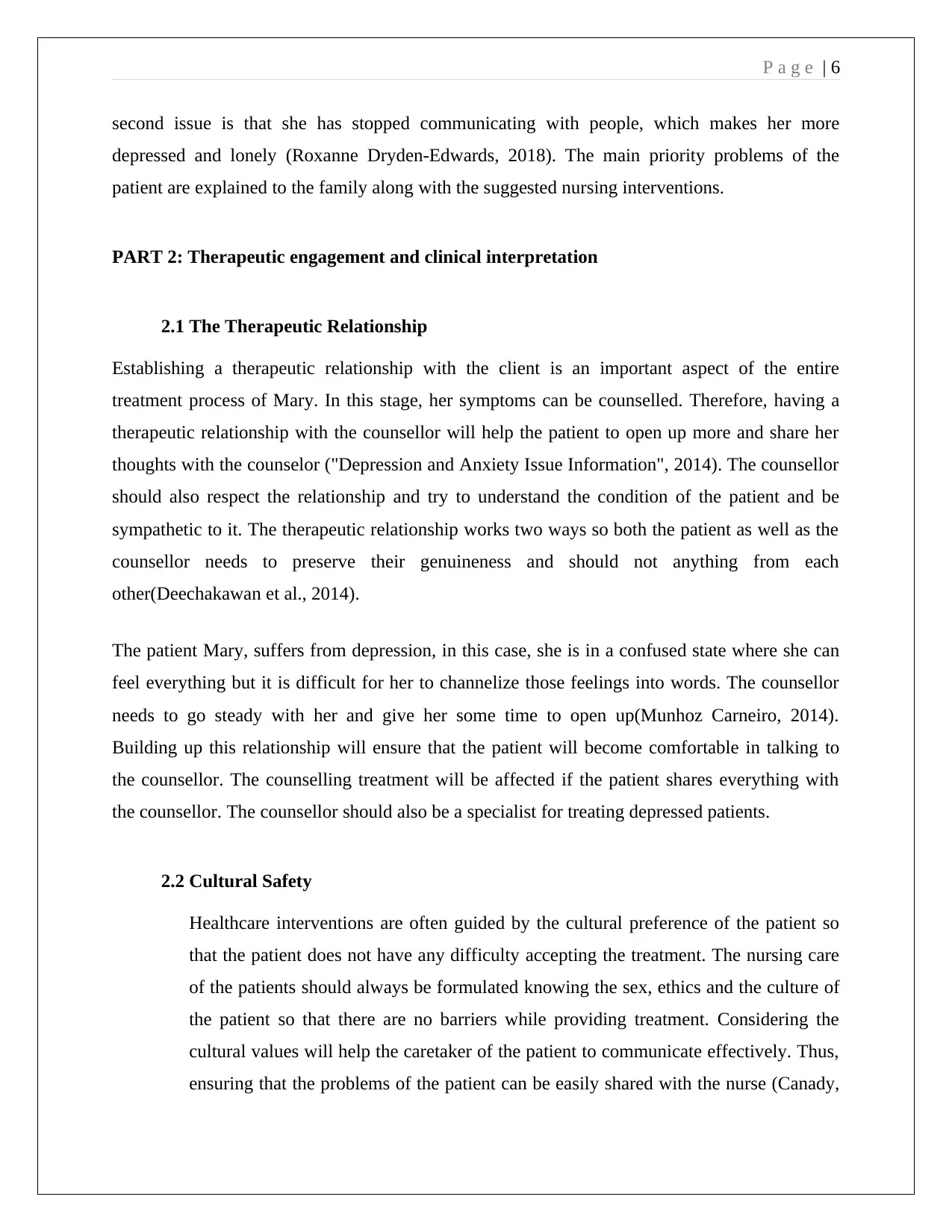
P a g e | 6
second issue is that she has stopped communicating with people, which makes her more
depressed and lonely (Roxanne Dryden-Edwards, 2018). The main priority problems of the
patient are explained to the family along with the suggested nursing interventions.
PART 2: Therapeutic engagement and clinical interpretation
2.1 The Therapeutic Relationship
Establishing a therapeutic relationship with the client is an important aspect of the entire
treatment process of Mary. In this stage, her symptoms can be counselled. Therefore, having a
therapeutic relationship with the counsellor will help the patient to open up more and share her
thoughts with the counselor ("Depression and Anxiety Issue Information", 2014). The counsellor
should also respect the relationship and try to understand the condition of the patient and be
sympathetic to it. The therapeutic relationship works two ways so both the patient as well as the
counsellor needs to preserve their genuineness and should not anything from each
other(Deechakawan et al., 2014).
The patient Mary, suffers from depression, in this case, she is in a confused state where she can
feel everything but it is difficult for her to channelize those feelings into words. The counsellor
needs to go steady with her and give her some time to open up(Munhoz Carneiro, 2014).
Building up this relationship will ensure that the patient will become comfortable in talking to
the counsellor. The counselling treatment will be affected if the patient shares everything with
the counsellor. The counsellor should also be a specialist for treating depressed patients.
2.2 Cultural Safety
Healthcare interventions are often guided by the cultural preference of the patient so
that the patient does not have any difficulty accepting the treatment. The nursing care
of the patients should always be formulated knowing the sex, ethics and the culture of
the patient so that there are no barriers while providing treatment. Considering the
cultural values will help the caretaker of the patient to communicate effectively. Thus,
ensuring that the problems of the patient can be easily shared with the nurse (Canady,
second issue is that she has stopped communicating with people, which makes her more
depressed and lonely (Roxanne Dryden-Edwards, 2018). The main priority problems of the
patient are explained to the family along with the suggested nursing interventions.
PART 2: Therapeutic engagement and clinical interpretation
2.1 The Therapeutic Relationship
Establishing a therapeutic relationship with the client is an important aspect of the entire
treatment process of Mary. In this stage, her symptoms can be counselled. Therefore, having a
therapeutic relationship with the counsellor will help the patient to open up more and share her
thoughts with the counselor ("Depression and Anxiety Issue Information", 2014). The counsellor
should also respect the relationship and try to understand the condition of the patient and be
sympathetic to it. The therapeutic relationship works two ways so both the patient as well as the
counsellor needs to preserve their genuineness and should not anything from each
other(Deechakawan et al., 2014).
The patient Mary, suffers from depression, in this case, she is in a confused state where she can
feel everything but it is difficult for her to channelize those feelings into words. The counsellor
needs to go steady with her and give her some time to open up(Munhoz Carneiro, 2014).
Building up this relationship will ensure that the patient will become comfortable in talking to
the counsellor. The counselling treatment will be affected if the patient shares everything with
the counsellor. The counsellor should also be a specialist for treating depressed patients.
2.2 Cultural Safety
Healthcare interventions are often guided by the cultural preference of the patient so
that the patient does not have any difficulty accepting the treatment. The nursing care
of the patients should always be formulated knowing the sex, ethics and the culture of
the patient so that there are no barriers while providing treatment. Considering the
cultural values will help the caretaker of the patient to communicate effectively. Thus,
ensuring that the problems of the patient can be easily shared with the nurse (Canady,
Paraphrase This Document
Need a fresh take? Get an instant paraphrase of this document with our AI Paraphraser
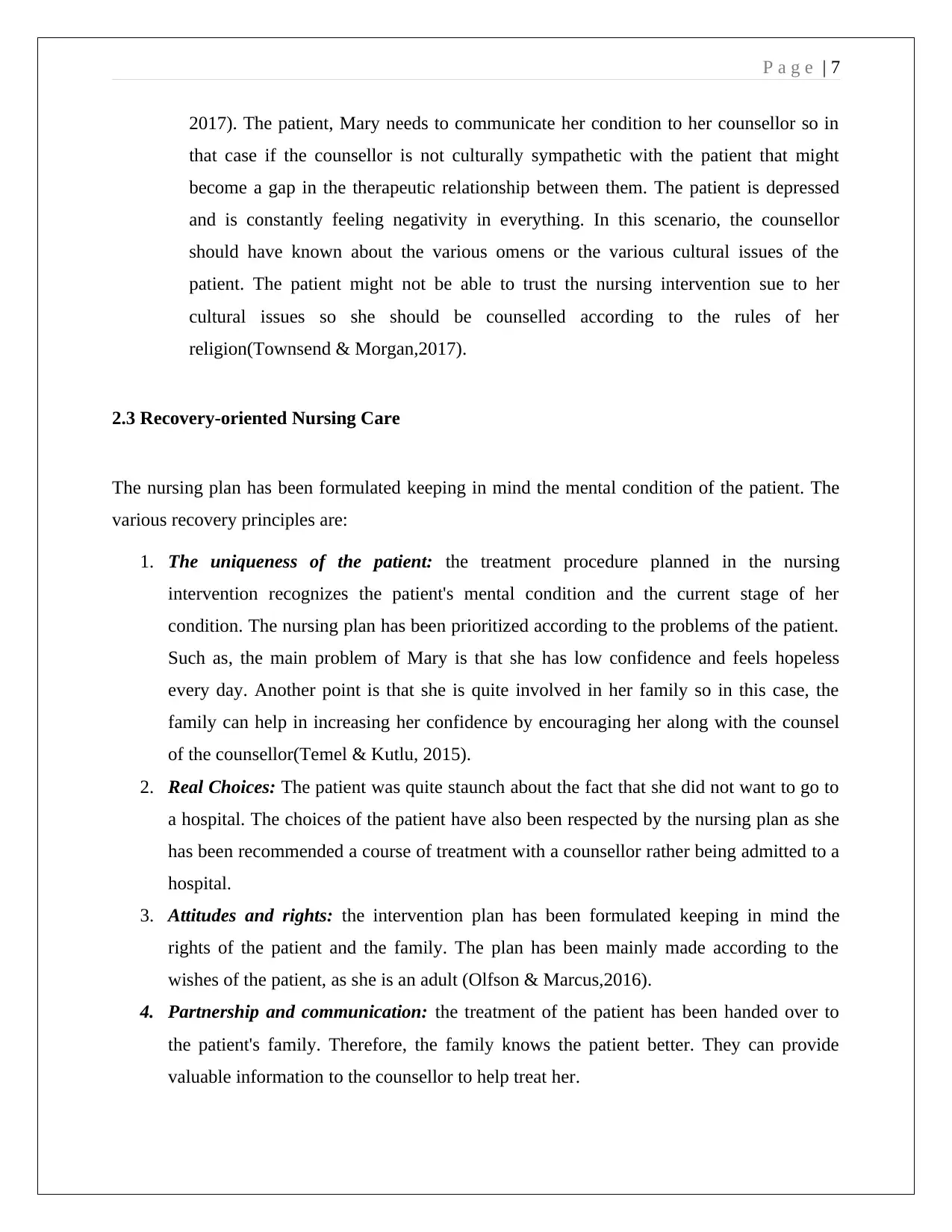
P a g e | 7
2017). The patient, Mary needs to communicate her condition to her counsellor so in
that case if the counsellor is not culturally sympathetic with the patient that might
become a gap in the therapeutic relationship between them. The patient is depressed
and is constantly feeling negativity in everything. In this scenario, the counsellor
should have known about the various omens or the various cultural issues of the
patient. The patient might not be able to trust the nursing intervention sue to her
cultural issues so she should be counselled according to the rules of her
religion(Townsend & Morgan,2017).
2.3 Recovery-oriented Nursing Care
The nursing plan has been formulated keeping in mind the mental condition of the patient. The
various recovery principles are:
1. The uniqueness of the patient: the treatment procedure planned in the nursing
intervention recognizes the patient's mental condition and the current stage of her
condition. The nursing plan has been prioritized according to the problems of the patient.
Such as, the main problem of Mary is that she has low confidence and feels hopeless
every day. Another point is that she is quite involved in her family so in this case, the
family can help in increasing her confidence by encouraging her along with the counsel
of the counsellor(Temel & Kutlu, 2015).
2. Real Choices: The patient was quite staunch about the fact that she did not want to go to
a hospital. The choices of the patient have also been respected by the nursing plan as she
has been recommended a course of treatment with a counsellor rather being admitted to a
hospital.
3. Attitudes and rights: the intervention plan has been formulated keeping in mind the
rights of the patient and the family. The plan has been mainly made according to the
wishes of the patient, as she is an adult (Olfson & Marcus,2016).
4. Partnership and communication: the treatment of the patient has been handed over to
the patient's family. Therefore, the family knows the patient better. They can provide
valuable information to the counsellor to help treat her.
2017). The patient, Mary needs to communicate her condition to her counsellor so in
that case if the counsellor is not culturally sympathetic with the patient that might
become a gap in the therapeutic relationship between them. The patient is depressed
and is constantly feeling negativity in everything. In this scenario, the counsellor
should have known about the various omens or the various cultural issues of the
patient. The patient might not be able to trust the nursing intervention sue to her
cultural issues so she should be counselled according to the rules of her
religion(Townsend & Morgan,2017).
2.3 Recovery-oriented Nursing Care
The nursing plan has been formulated keeping in mind the mental condition of the patient. The
various recovery principles are:
1. The uniqueness of the patient: the treatment procedure planned in the nursing
intervention recognizes the patient's mental condition and the current stage of her
condition. The nursing plan has been prioritized according to the problems of the patient.
Such as, the main problem of Mary is that she has low confidence and feels hopeless
every day. Another point is that she is quite involved in her family so in this case, the
family can help in increasing her confidence by encouraging her along with the counsel
of the counsellor(Temel & Kutlu, 2015).
2. Real Choices: The patient was quite staunch about the fact that she did not want to go to
a hospital. The choices of the patient have also been respected by the nursing plan as she
has been recommended a course of treatment with a counsellor rather being admitted to a
hospital.
3. Attitudes and rights: the intervention plan has been formulated keeping in mind the
rights of the patient and the family. The plan has been mainly made according to the
wishes of the patient, as she is an adult (Olfson & Marcus,2016).
4. Partnership and communication: the treatment of the patient has been handed over to
the patient's family. Therefore, the family knows the patient better. They can provide
valuable information to the counsellor to help treat her.
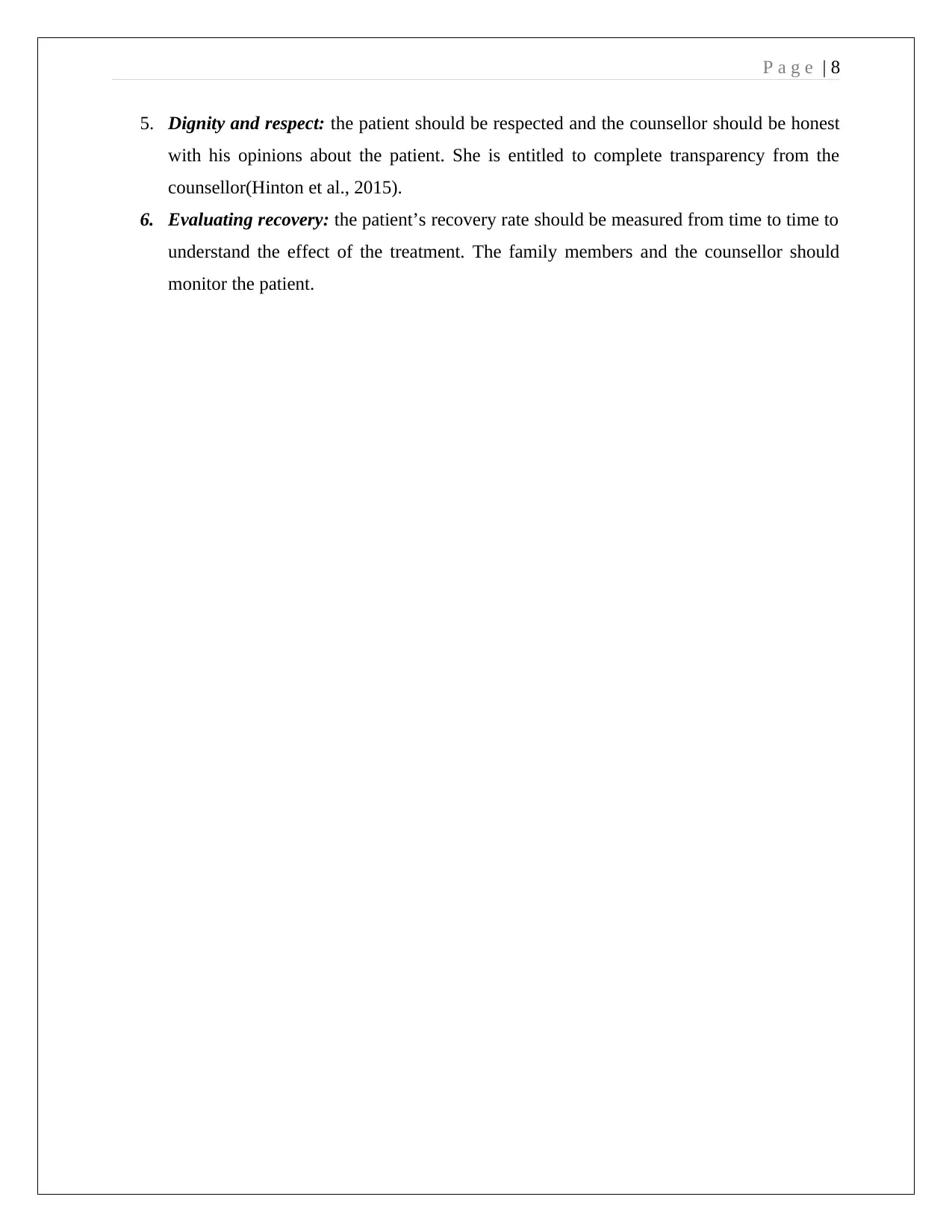
P a g e | 8
5. Dignity and respect: the patient should be respected and the counsellor should be honest
with his opinions about the patient. She is entitled to complete transparency from the
counsellor(Hinton et al., 2015).
6. Evaluating recovery: the patient’s recovery rate should be measured from time to time to
understand the effect of the treatment. The family members and the counsellor should
monitor the patient.
5. Dignity and respect: the patient should be respected and the counsellor should be honest
with his opinions about the patient. She is entitled to complete transparency from the
counsellor(Hinton et al., 2015).
6. Evaluating recovery: the patient’s recovery rate should be measured from time to time to
understand the effect of the treatment. The family members and the counsellor should
monitor the patient.
⊘ This is a preview!⊘
Do you want full access?
Subscribe today to unlock all pages.

Trusted by 1+ million students worldwide
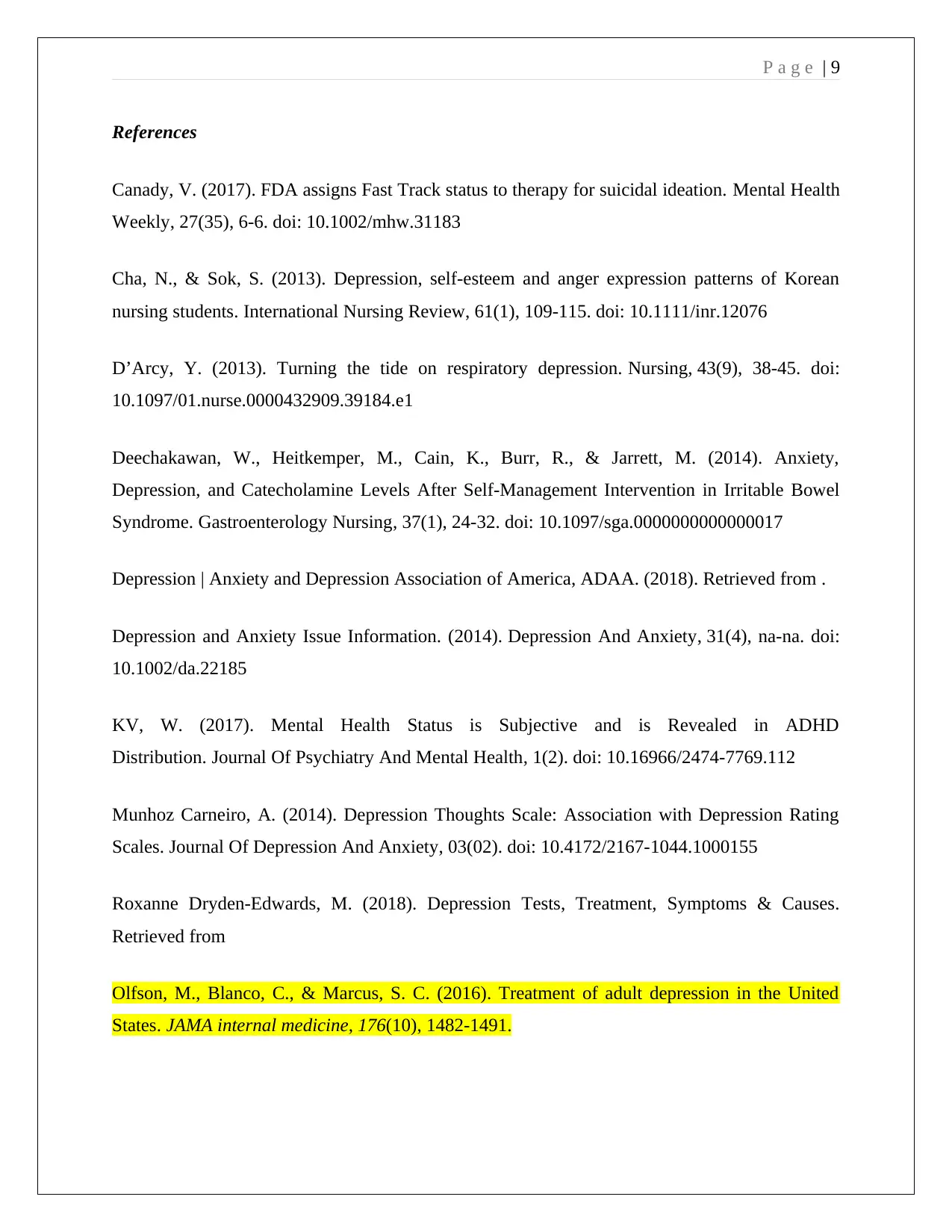
P a g e | 9
References
Canady, V. (2017). FDA assigns Fast Track status to therapy for suicidal ideation. Mental Health
Weekly, 27(35), 6-6. doi: 10.1002/mhw.31183
Cha, N., & Sok, S. (2013). Depression, self-esteem and anger expression patterns of Korean
nursing students. International Nursing Review, 61(1), 109-115. doi: 10.1111/inr.12076
DʼArcy, Y. (2013). Turning the tide on respiratory depression. Nursing, 43(9), 38-45. doi:
10.1097/01.nurse.0000432909.39184.e1
Deechakawan, W., Heitkemper, M., Cain, K., Burr, R., & Jarrett, M. (2014). Anxiety,
Depression, and Catecholamine Levels After Self-Management Intervention in Irritable Bowel
Syndrome. Gastroenterology Nursing, 37(1), 24-32. doi: 10.1097/sga.0000000000000017
Depression | Anxiety and Depression Association of America, ADAA. (2018). Retrieved from .
Depression and Anxiety Issue Information. (2014). Depression And Anxiety, 31(4), na-na. doi:
10.1002/da.22185
KV, W. (2017). Mental Health Status is Subjective and is Revealed in ADHD
Distribution. Journal Of Psychiatry And Mental Health, 1(2). doi: 10.16966/2474-7769.112
Munhoz Carneiro, A. (2014). Depression Thoughts Scale: Association with Depression Rating
Scales. Journal Of Depression And Anxiety, 03(02). doi: 10.4172/2167-1044.1000155
Roxanne Dryden-Edwards, M. (2018). Depression Tests, Treatment, Symptoms & Causes.
Retrieved from
Olfson, M., Blanco, C., & Marcus, S. C. (2016). Treatment of adult depression in the United
States. JAMA internal medicine, 176(10), 1482-1491.
References
Canady, V. (2017). FDA assigns Fast Track status to therapy for suicidal ideation. Mental Health
Weekly, 27(35), 6-6. doi: 10.1002/mhw.31183
Cha, N., & Sok, S. (2013). Depression, self-esteem and anger expression patterns of Korean
nursing students. International Nursing Review, 61(1), 109-115. doi: 10.1111/inr.12076
DʼArcy, Y. (2013). Turning the tide on respiratory depression. Nursing, 43(9), 38-45. doi:
10.1097/01.nurse.0000432909.39184.e1
Deechakawan, W., Heitkemper, M., Cain, K., Burr, R., & Jarrett, M. (2014). Anxiety,
Depression, and Catecholamine Levels After Self-Management Intervention in Irritable Bowel
Syndrome. Gastroenterology Nursing, 37(1), 24-32. doi: 10.1097/sga.0000000000000017
Depression | Anxiety and Depression Association of America, ADAA. (2018). Retrieved from .
Depression and Anxiety Issue Information. (2014). Depression And Anxiety, 31(4), na-na. doi:
10.1002/da.22185
KV, W. (2017). Mental Health Status is Subjective and is Revealed in ADHD
Distribution. Journal Of Psychiatry And Mental Health, 1(2). doi: 10.16966/2474-7769.112
Munhoz Carneiro, A. (2014). Depression Thoughts Scale: Association with Depression Rating
Scales. Journal Of Depression And Anxiety, 03(02). doi: 10.4172/2167-1044.1000155
Roxanne Dryden-Edwards, M. (2018). Depression Tests, Treatment, Symptoms & Causes.
Retrieved from
Olfson, M., Blanco, C., & Marcus, S. C. (2016). Treatment of adult depression in the United
States. JAMA internal medicine, 176(10), 1482-1491.
Paraphrase This Document
Need a fresh take? Get an instant paraphrase of this document with our AI Paraphraser
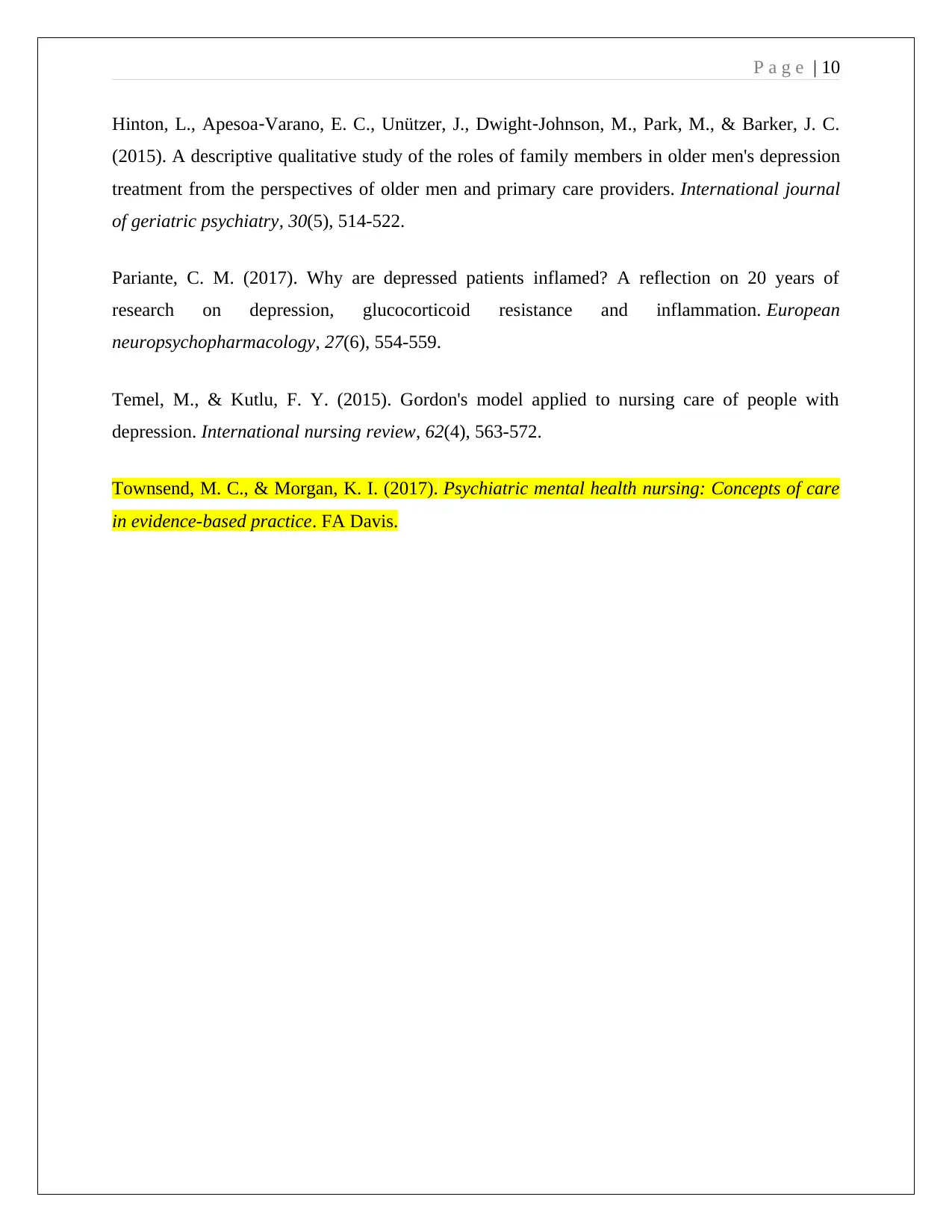
P a g e | 10
Hinton, L., Apesoa‐Varano, E. C., Unützer, J., Dwight‐Johnson, M., Park, M., & Barker, J. C.
(2015). A descriptive qualitative study of the roles of family members in older men's depression
treatment from the perspectives of older men and primary care providers. International journal
of geriatric psychiatry, 30(5), 514-522.
Pariante, C. M. (2017). Why are depressed patients inflamed? A reflection on 20 years of
research on depression, glucocorticoid resistance and inflammation. European
neuropsychopharmacology, 27(6), 554-559.
Temel, M., & Kutlu, F. Y. (2015). Gordon's model applied to nursing care of people with
depression. International nursing review, 62(4), 563-572.
Townsend, M. C., & Morgan, K. I. (2017). Psychiatric mental health nursing: Concepts of care
in evidence-based practice. FA Davis.
Hinton, L., Apesoa‐Varano, E. C., Unützer, J., Dwight‐Johnson, M., Park, M., & Barker, J. C.
(2015). A descriptive qualitative study of the roles of family members in older men's depression
treatment from the perspectives of older men and primary care providers. International journal
of geriatric psychiatry, 30(5), 514-522.
Pariante, C. M. (2017). Why are depressed patients inflamed? A reflection on 20 years of
research on depression, glucocorticoid resistance and inflammation. European
neuropsychopharmacology, 27(6), 554-559.
Temel, M., & Kutlu, F. Y. (2015). Gordon's model applied to nursing care of people with
depression. International nursing review, 62(4), 563-572.
Townsend, M. C., & Morgan, K. I. (2017). Psychiatric mental health nursing: Concepts of care
in evidence-based practice. FA Davis.
1 out of 11
Related Documents
Your All-in-One AI-Powered Toolkit for Academic Success.
+13062052269
info@desklib.com
Available 24*7 on WhatsApp / Email
![[object Object]](/_next/static/media/star-bottom.7253800d.svg)
Unlock your academic potential
Copyright © 2020–2025 A2Z Services. All Rights Reserved. Developed and managed by ZUCOL.





